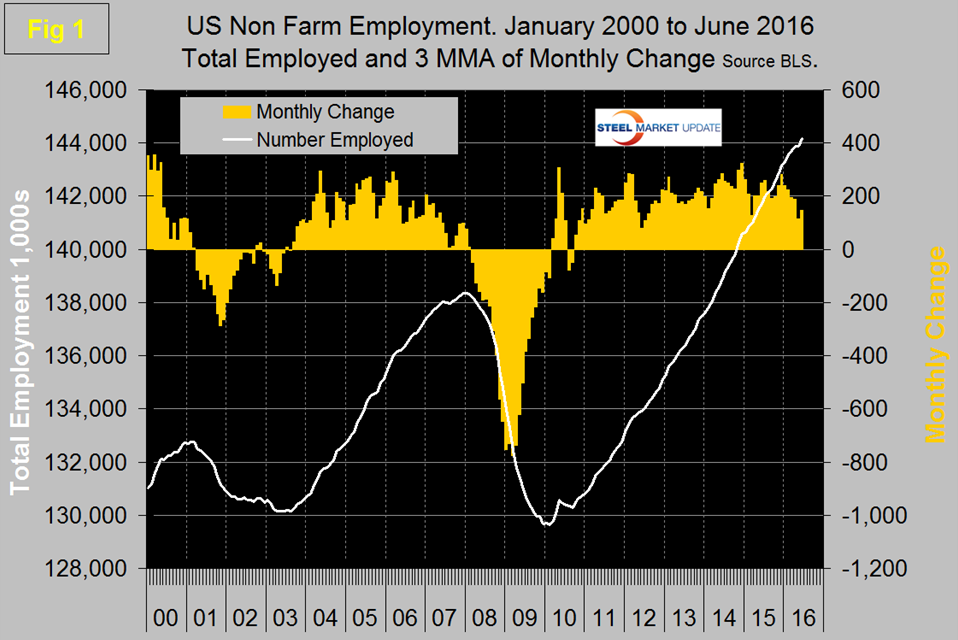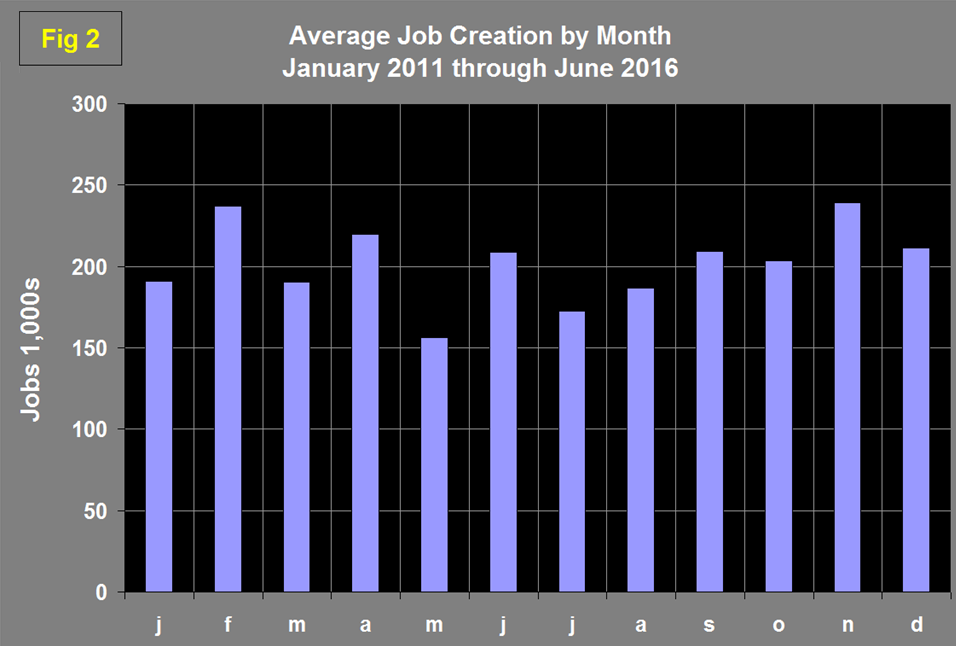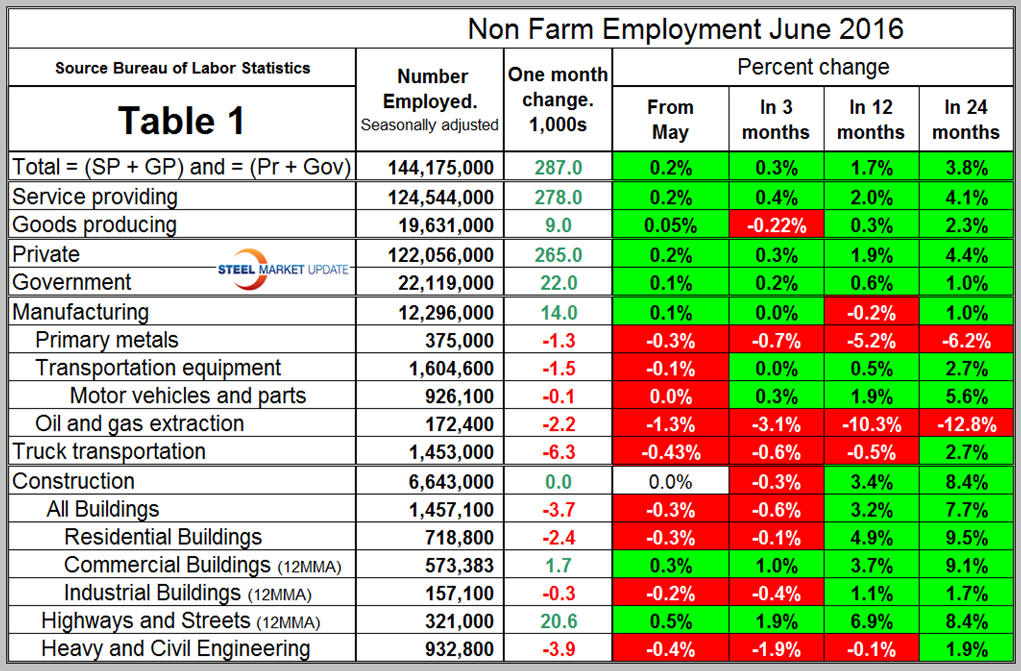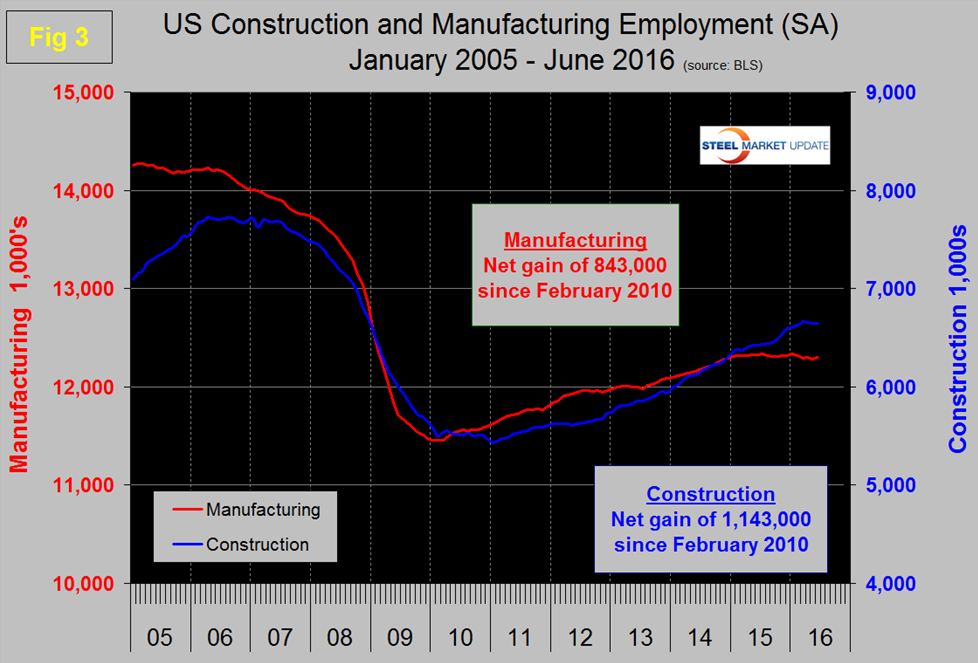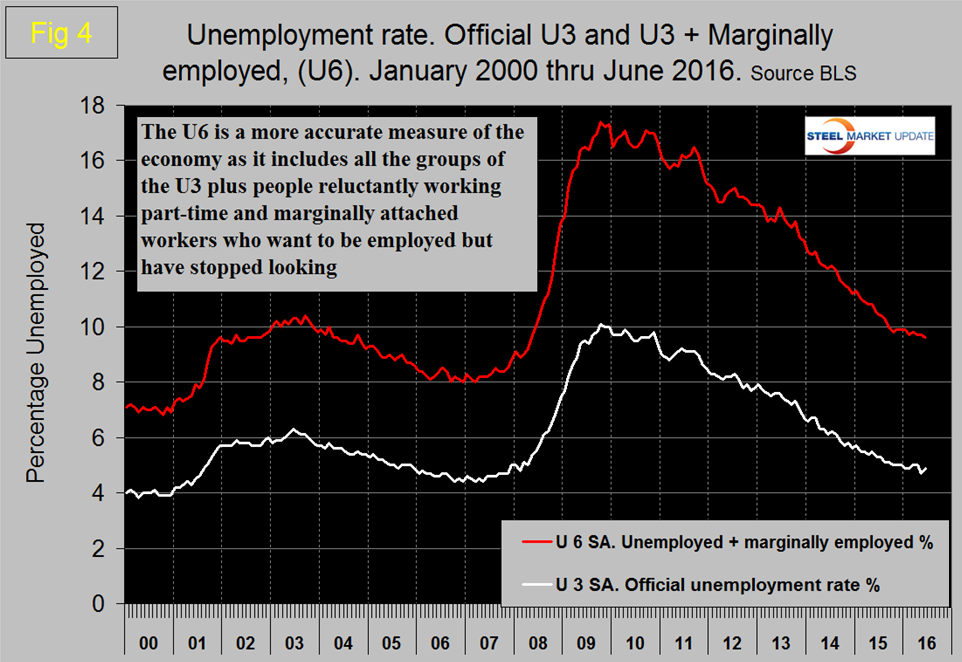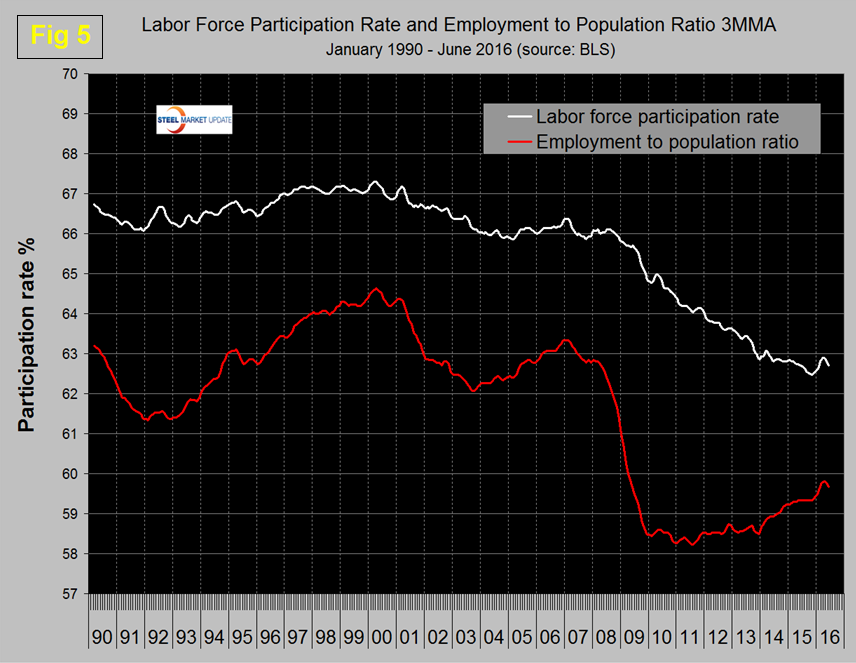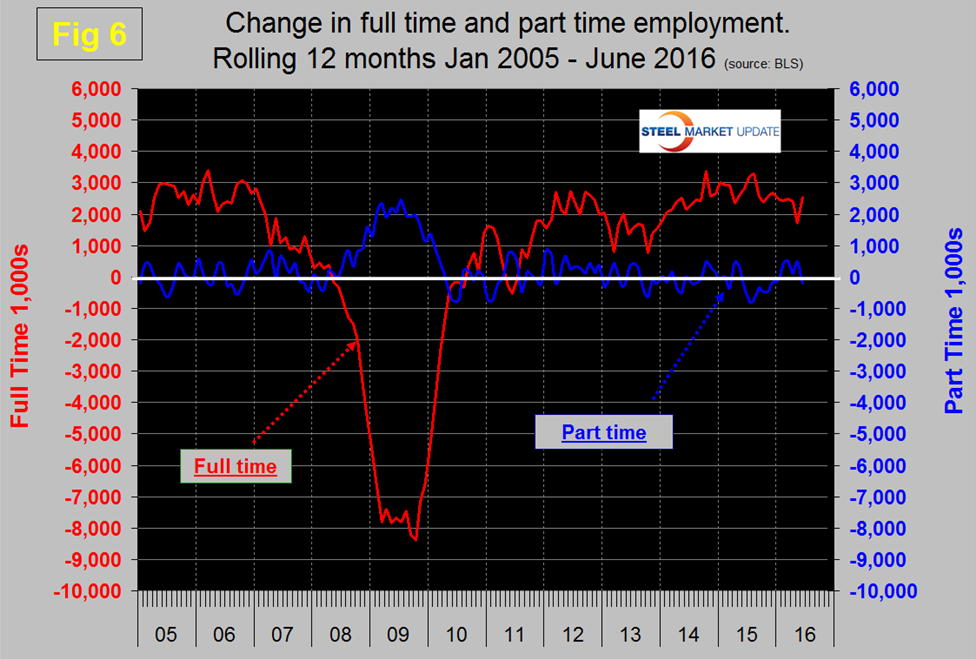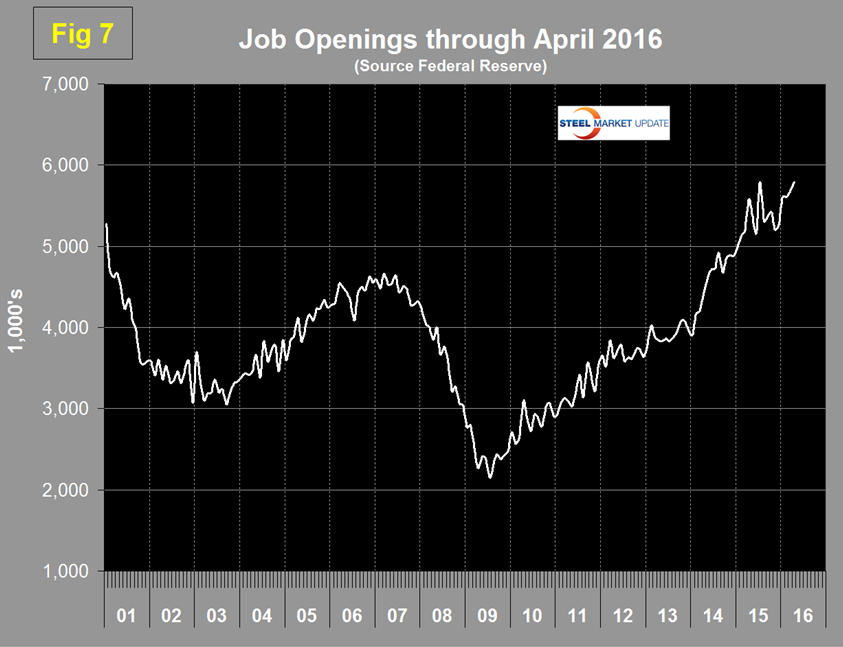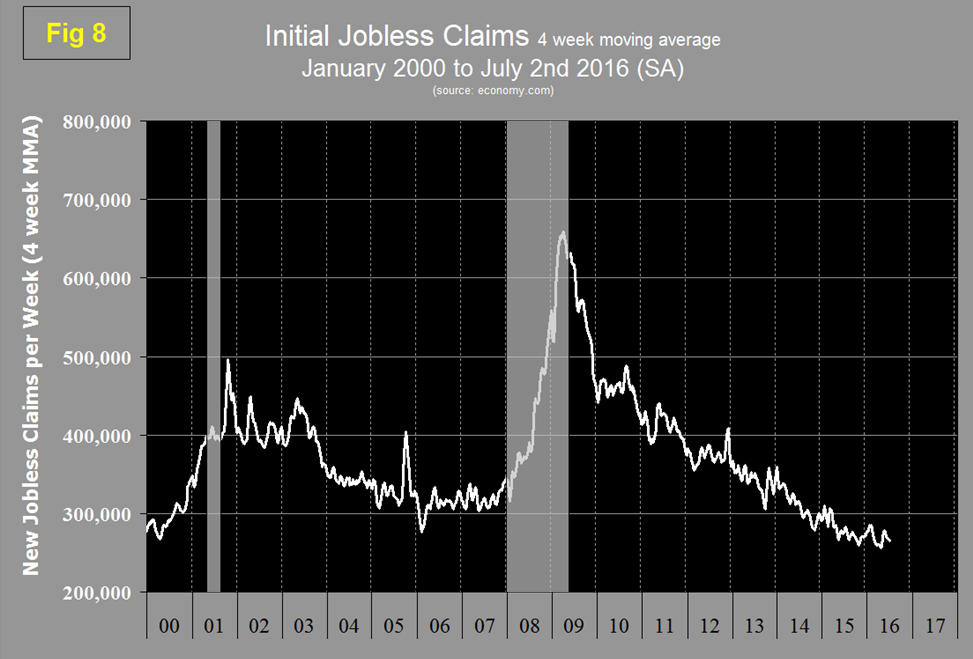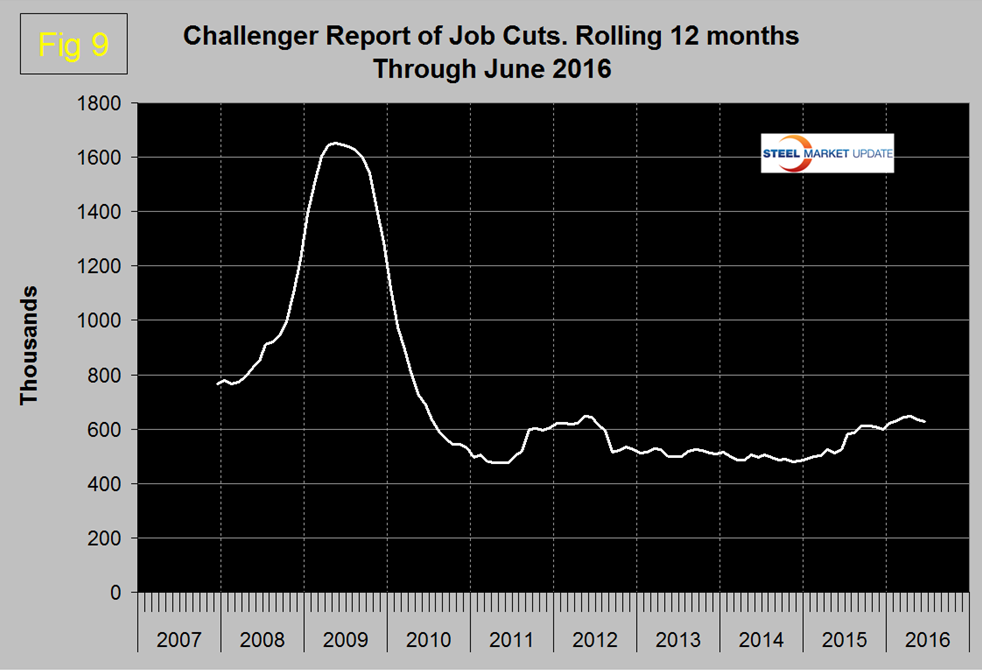Economy

Net Job Creation by Industry through June 2016
Written by Peter Wright
July 11, 2016
The statement of Erica L. Groshe Commissioner Bureau of Labor Statistics (BLS) released on Friday morning reads as though the increase in net non-farm employment of 287,000 in June was a fact as was the downwardly revised May number of 11,000. We at SMU don’t believe the May result has any credibility which is particularly troubling because the original result of a 38,000 gain was believed to have a major influence on the Feds decision not to raise rates in their June 14th and 15th meeting (see extracts from the Federal Open Market Committee (FOMC) minutes below.) The Fed didn’t raise its benchmark interest rate in June because officials worried about the “surprisingly weak May employment report”. The following are extracts from the minutes of the FOMC meeting held on June 14th and 15th.
![]() “Total nonfarm payroll employment gains slowed in April and May, even after adjusting for the effects of a strike at a large telecommunications company. The unemployment rate dropped to 4.7 percent in May, partly reflecting an unusually large number of unemployed persons exiting the labor force. Over the first two months of the second quarter, both the labor force participation rate and the employment-to-population ratio moved down on net. The share of workers employed part time for economic reasons rose noticeably in May. Although the rate of private-sector job openings remained elevated, the rate of hires declined in both March and April and the rate of quits was unchanged. The four-week moving average of initial claims for unemployment insurance benefits moved up a little, on net, from late April to early June but was still at a low level. Labor productivity growth remained slow over the four quarters ending in the first quarter of 2016. “Effective June 16, 2016, the Federal Open Market Committee directs the Desk to undertake open market operations as necessary to maintain the federal funds rate in a target range of ¼ to ½ percent, including overnight reverse repurchase operations at an offering rate of 0.25 percent, in amounts limited only by the value of Treasury securities held outright in the System Open Market Account that are available for such operations and by a per-counterparty limit of $30 billion per day.”
“Total nonfarm payroll employment gains slowed in April and May, even after adjusting for the effects of a strike at a large telecommunications company. The unemployment rate dropped to 4.7 percent in May, partly reflecting an unusually large number of unemployed persons exiting the labor force. Over the first two months of the second quarter, both the labor force participation rate and the employment-to-population ratio moved down on net. The share of workers employed part time for economic reasons rose noticeably in May. Although the rate of private-sector job openings remained elevated, the rate of hires declined in both March and April and the rate of quits was unchanged. The four-week moving average of initial claims for unemployment insurance benefits moved up a little, on net, from late April to early June but was still at a low level. Labor productivity growth remained slow over the four quarters ending in the first quarter of 2016. “Effective June 16, 2016, the Federal Open Market Committee directs the Desk to undertake open market operations as necessary to maintain the federal funds rate in a target range of ¼ to ½ percent, including overnight reverse repurchase operations at an offering rate of 0.25 percent, in amounts limited only by the value of Treasury securities held outright in the System Open Market Account that are available for such operations and by a per-counterparty limit of $30 billion per day.”
Last month we wrote regarding the May result, “The BLS reported that 38,000 jobs were added in May, a result so poor and unexpected as to be barely credible. Mitigating circumstances were the Verizon strike that removed about 34,000 from the employed pool and secondly that in the last six years May has been down by 28 percent from April. Even with those caveats, the June result was dismal and doesn’t jive with the other economic data that we study”.
At SMU we almost always use three month moving averages to mitigate situations like this where a single months numbers don’t jive with the longer term trend but this case is so extreme that this technique doesn’t adequately smooth the result. The 3MMA of gains through June was 147,000, up from 114,000 in May. Figure 1 shows the 3MMA of the number of jobs created as the brown bars and it is evident that there has been a decline during the course of this year.
These numbers are seasonally adjusted by the BLS so to examine if any seasonality is left in the data after adjustment we have developed Figure 2.
The January dip is a weather effect and July is depressed by automotive plant re-tooling but we have no explanation for the historic May decline. Evidently the seasonal adjustment is less than perfect. Total nonfarm payrolls are now 5,810,000 more than they were at the pre-recession high of January 2008.
Table 1 slices total employment into service and goods producing industries and then into private and government employees.
Total employment equals the sum of private and government employees. It also equals the sum of goods producing and service employees. Most of the goods producing employees work in manufacturing and construction and the major components of these two sectors are also shown in Table 1. In June, 265,000 jobs were created in the private sector and 22,000 in government. The Federal government gained 2,000 as state governments gained 3,000 and local governments gained 17,000. Since February 2010, the employment low point, private employers have added 14,799,000 jobs as government has shed 357,000. In June service industries expanded by 278,000 as goods producing industries gained 9,000 people. Since February 2010, service industries have added 12,438,000 and goods producing 2,004,000 positions. This is part of the reason for stagnant wage growth since service industries on average pay less than goods producing such as manufacturing.
In June manufacturing gained 14,000 jobs but total manufacturing employment was 0.2 percent less than a year ago. In the first half of 2016, manufacturing has lost 24,000 jobs after gaining 8,000 in the second half of last year. Primary metals lost 12,000 in the 2nd half of 20015, lost 9,000 in the 1st half of this year and has had only one positive month out of the last eighteen. Table 1 shows that in June there were no positive results in the five manufacturing sectors that we examine. Note the subcomponents of both manufacturing and construction shown in Table 1 don’t add up to the total because we have only included those that have most relevance to the steel industry.
Construction was reported to have broken even in June. April and May were the only months to have a contraction in construction employment since March last year. The construction data in particular conflicts with the positive construction expenditures report (CPIP) issued by the Department of Commerce and which we reported on last week. The Associated General Contractors of America may have an explanation for this discrepancy and had this to say in their blog dated July 8th. Construction employment was unchanged from May to June, but an increase in hourly pay and longer workweeks, along with shrinking numbers of unemployed construction workers, suggest contractors would hire more workers if they were available. Association officials said the lack of available qualified workers for firms to hire appears to be holding back employment growth and urged Congress to pass legislation to reform and increase funding for career and technical education. Unemployment among construction workers is at a 16-year low, while average hourly earnings have accelerated for the past three months and average weekly hours are very high,” said Ken Simonson, the association’s chief economist. “These indicators, along with reports from contractors, suggest there is a dearth of qualified workers to hire, not a deliberate pullback in hiring. Indeed, construction activity and employment should continue to outpace the overall economy in the remainder of 2016.”
Some of the major construction sub categories are routinely reported one month in arrears which distorts the data in Table 1. These include, industrial buildings, commercial buildings and highways and streets. Construction has added 1,143,000 jobs and manufacturing 843,000 since the recessionary employment low point in February 2010 (Figure 3).
Construction has leapt ahead of manufacturing as a job creator but the growth of construction productivity is very low (or non-existent), in contrast to manufacturing where it is very high. The difference is the difficulty of automating construction jobs.
The official unemployment rate, U3, calculated from a different survey, rose to 4.9 percent in June from 4.7 percent in May and back to where it was in February. This number doesn’t take into consideration those who have stopped looking. The more comprehensive U6 unemployment rate decreased from 11.3 percent in January 2015 to 9.7 percent in April and May this year then down to 9.6 percent in June (Figure 4).
U6 includes workers working part time who desire full time work and people who want to work but are so discouraged that they have stopped looking. The differential between these rates was usually less than 4 percent before the recession but is still 4.7 percent.
The employment participation rate is widely quoted in the press as going nowhere. In June 2016 the rate was 62.7 percent, with a 3MMA also of 62.7 percent down from 62.9 percent in April. We’re not sure that we understand what this is a percentage “of” because of the multiple descriptions of the labor pool. Another measure is the number employed as a percentage of the population which we think is much more definitive. In June this measure stood at 59.6 percent with a 3MMA of 59.7 percent which was down from 59.8 percent in March through May. Figure 5 shows both measures on one graph.
In the 18 months since and including January 2015 there has been an increase of 3,652,000 full time and a decrease of 61,000 part time jobs. Figure 6 shows the rolling 12 month total change in both part time and full time employment.
Frequently in the press we read that a large part of job creation is in part time employment which in some months is true but the part-time numbers are extremely volatile. To overcome the volatility we have to look at longer time periods than a month or even a quarter which is why we look at a rolling 12 months for this component of the employment picture.
The job openings report known as JOLTS is reported on about the 10th of the month by the Federal Reserve and is over a month in arrears. Figure 7 shows the history of unfilled job openings through April.
Openings have skyrocketed in the last two years to levels not seen since the data series was initiated in 2000. The previous high was 5.788 million at the end of July last year and this was exactly equaled in the latest data for April this year.
Initial claims for unemployment insurance have been relatively consistent for the last year. The four week moving average of new claims at the beginning of July was down by 5,000 from the beginning of June and was lower than at any time in the last 43 years (1973) (Figure 8).
The last piece of the employment puzzle that we examine is the Challenger report which measures job cuts monthly (Figure 9).
This data also tends to be quite erratic therefore again we examine a rolling 12 months and can see that job cute increased in the 2nd half of 2015 but not excessively so.
SMU Comment: We are trying here to make sense of what we believe is bad data from the BLS and as far as we can see the employment situation is good though there has been a slowdown in job creation this year. There is a lot riding on the data, not least the value of the US $ which is driven significantly by the differential between US interest rates and those of the other major global economies. We suppose we shouldn’t complain if inaccurately low job creation numbers cause the Fed not to raise interest rates which slows the appreciation of the US $ which reduces the pressure on net imports.
Explanation: On the first Friday of each month the Bureau of Labor Statistics releases the employment data for the previous month. Data is available at www.bls.gov. At SMU we track the job creation numbers by many different categories. The BLS data base is a reality check for other economic data streams such as manufacturing and construction and we include the net job creation figures for those two sectors in our “Key Indicators” report. It is easy to drill down into the BLS data base to obtain employment data for many sub sectors of the economy. For example, among hundreds of sub-indexes are truck transportation, auto production and primary metals production. The important point about each of these hundreds of data streams is in which direction they are headed. Whenever possible we at SMU try to track three separate data sources for a given steel related sector of the economy. We believe this gives a reasonable picture of market direction. The BLS data is one of the most important sources of fine grained economic data that we use in our analyses. The States also collect their own employment numbers independently of the BLS. The compiled state data compares well with the federal data. Every three months SMU examines the state data and provides a regional report which indicates strength of weakness on a geographic basis. Reports by individual state can be produced on request.

Peter Wright
Read more from Peter WrightLatest in Economy

New York state manufacturing index drops again in April
Firms were pessimistic, with the future general business conditions index falling to its second lowest reading in the more than 20-year history of the survey

Construction adds 13,000 jobs in March
The construction sector added 13,000 jobs, seasonally adjusted, in March, but tariffs could undermine the industry.

Supply chains, end-users brace for impact from tariffs
Supply chains are working through what the tariffs mean for them

ISM: Manufacturing expansion loses steam after two months of growth
US manufacturing activity slowed in March after two straight months of expansion, according to supply executives contributing to the Institute for Supply Management (ISM)’s latest report.

Chicago Business Barometer rose to 16-month high in March
The Chicago Business Barometer increased for the third-consecutive month in March. Despite this, it still reflects contracting business conditions, as it has since December 2023.

